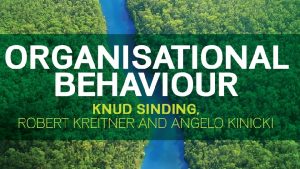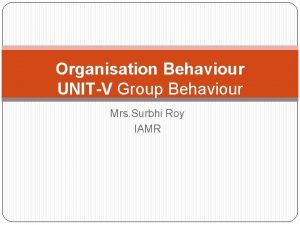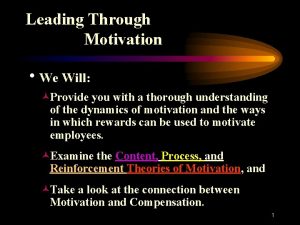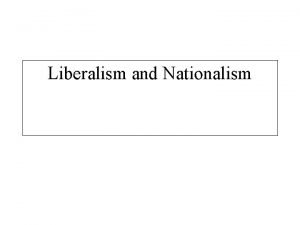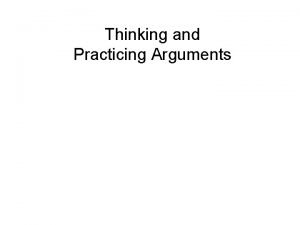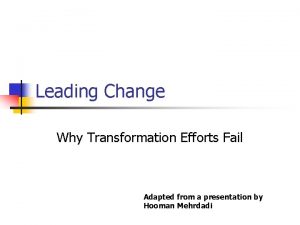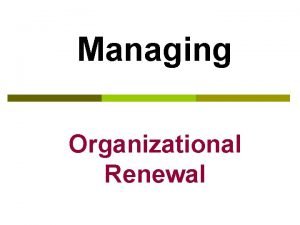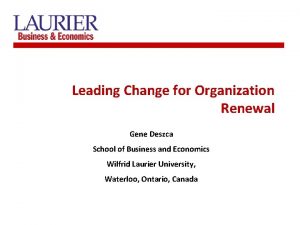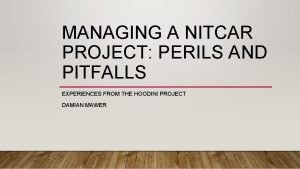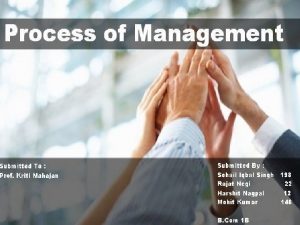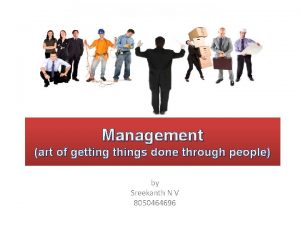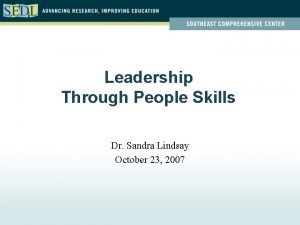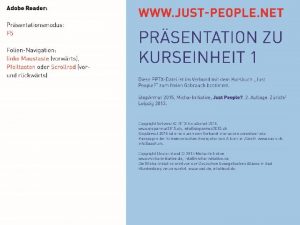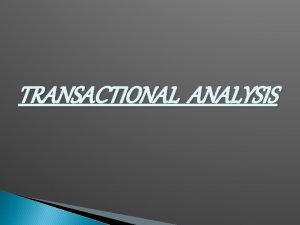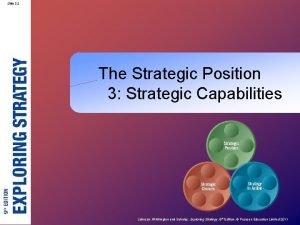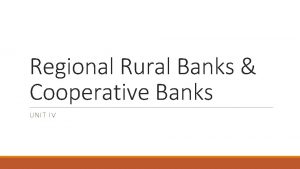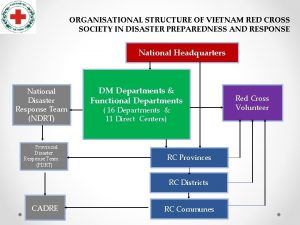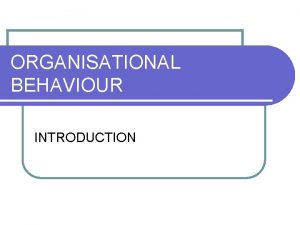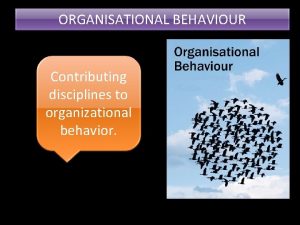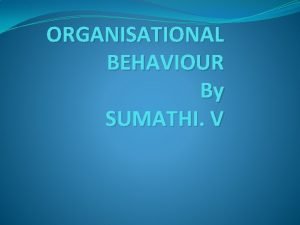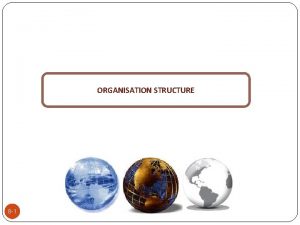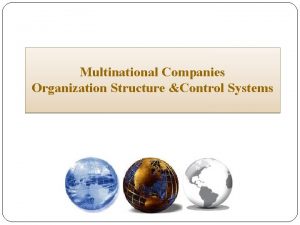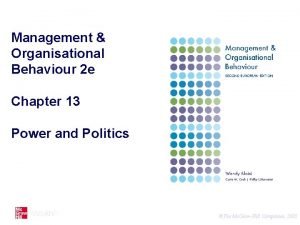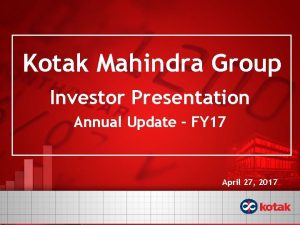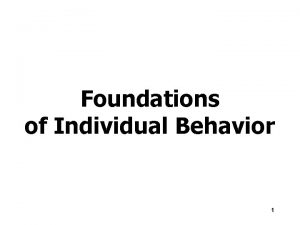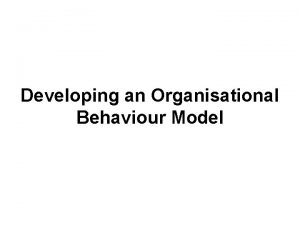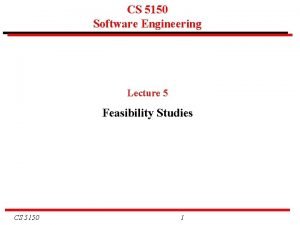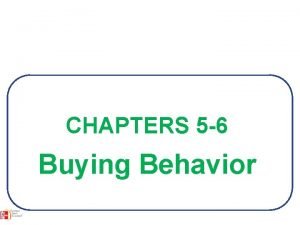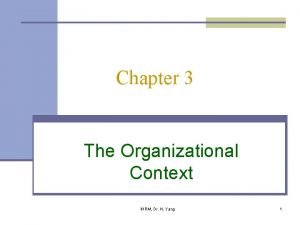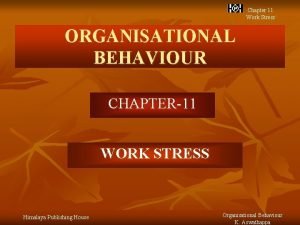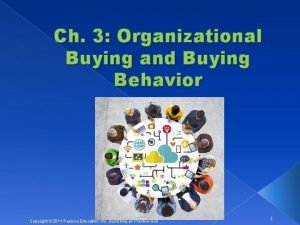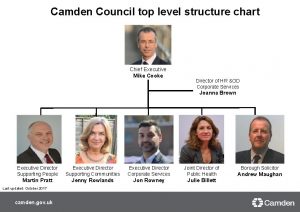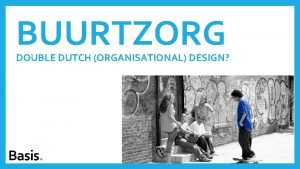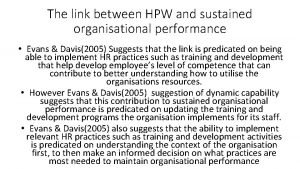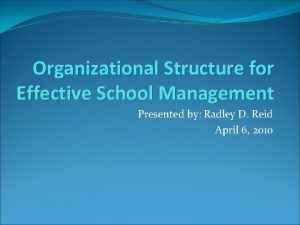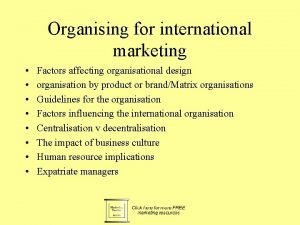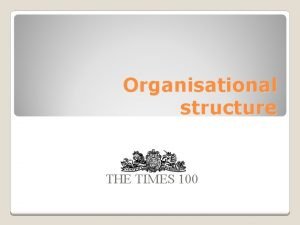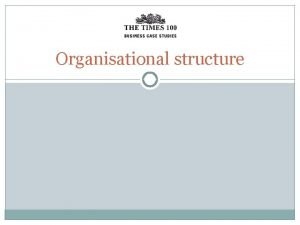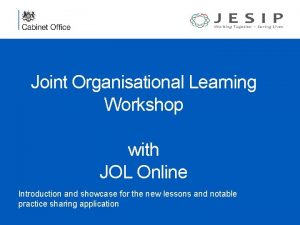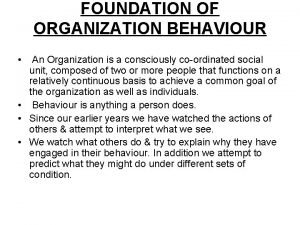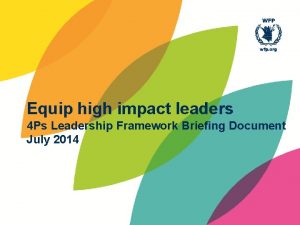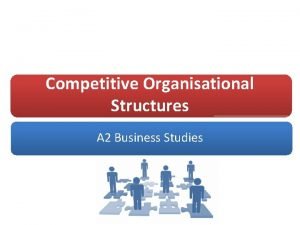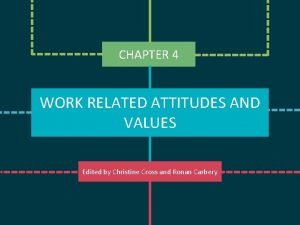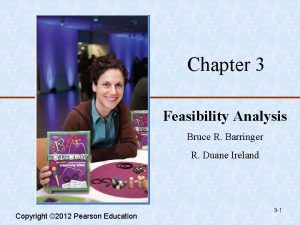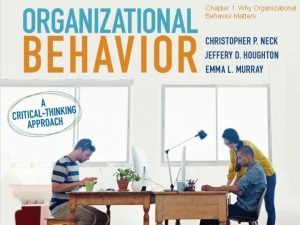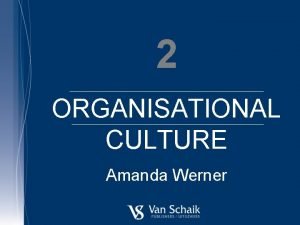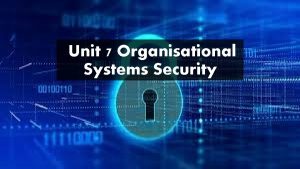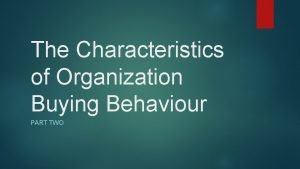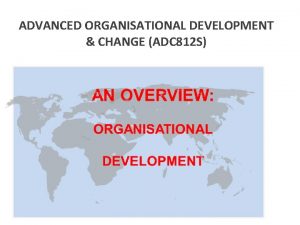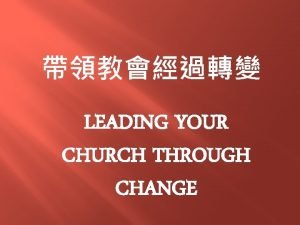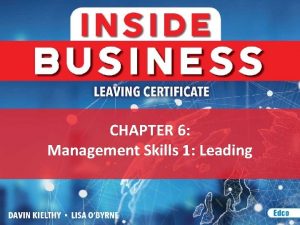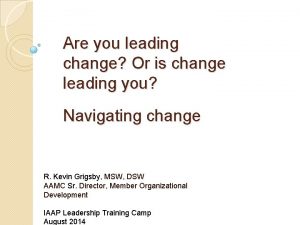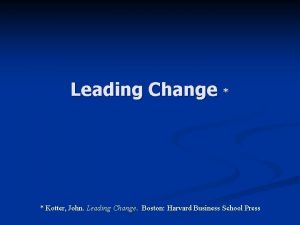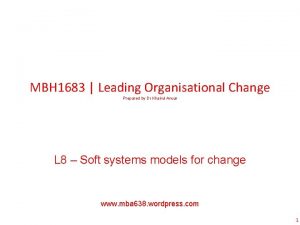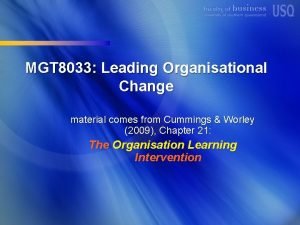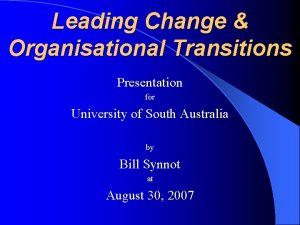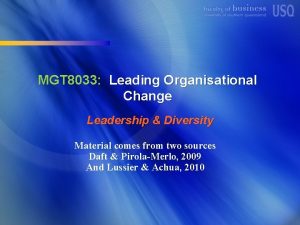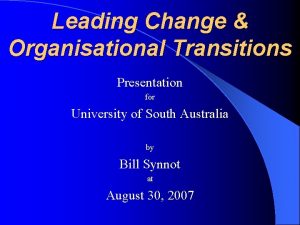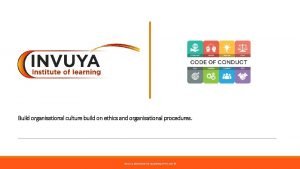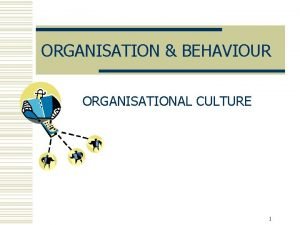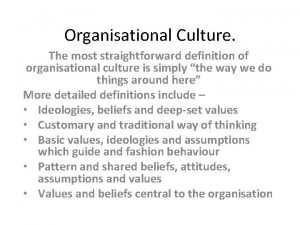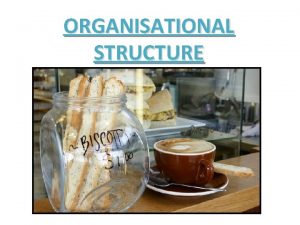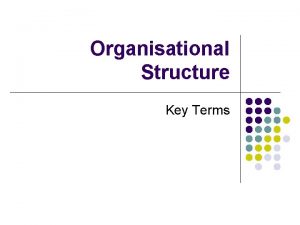Dynamics of Change Leading People Through Organisational Change










































































- Slides: 74

Dynamics of Change Leading People Through Organisational Change December 2015

Remember! Every change is UNIQUE to every individual, team and every q situation! We must ADJUST and ALIGN the process to every change q initiative! Every change initiative calls for BALANCE between the RATIONAL q and EMOTIONAL reality! Complex and large changes calls for INVOLVEMENT, q UNDERSTANDING and COOPERATION between all stakeholders We connect to changes through investing time in DIALOGUE! q www. valuescentre. com Powerful metrics that enable leaders to measure and manage cultures. 2

To lead people through change To grow a shared culture www. valuescentre. com Powerful metrics that enable leaders to measure and manage cultures. 3

It is not the strongest who survive, nor the most intelligent, but those who are most responsive to change. www. valuescentre. com Powerful metrics that enable leaders to measure and manage cultures. 4

The Dynamics of Change Reflections on the human side of leading people through organizational change • • • Improve our awareness and understanding Create a shared language and pictures Enable space for reflection and learning Offer practical tips and dialogue tools Make the intangible more tangible www. valuescentre. com Powerful metrics that enable leaders to measure and manage cultures. 5

Content of Dynamics of Change 1. 2. 3. 4. 5. 6. 7. 8. 9. 10. Change vs. Transformation Leadership Challenges Learning Planning Communication Human reactions Stress Firm leadership Building a foundation for change Exercises www. valuescentre. com Powerful metrics that enable leaders to measure and manage cultures. 6

The Dynamics of Change 10 Tools Your ”Psychological Contract” – Is it strong or weak? The Change Curve – Our present picture Diagnostic Questions – How do your employees feel? Support System – A self-assessment Force Field Analysis – Resisting or driving forces? Stakeholder Analysis – Create shared expectations Balanced Action Plan – Both content and process Team Reflection – Conditions for learning Levels – Where are we? Future Dialogue – Preferred and Probable p. 84 p. 86 p. 88 p. 89 p. 92 p. 94 p. 95 p. 97 p. 99 p. 101 www. valuescentre. com Powerful metrics that enable leaders to measure and manage cultures. 7

Employee focus during change Not primary Primary □ Structure □ Leadership □ Organizational charts □ The people in a team □ Steering system □ New way of thinking and acting □ Budgets □ Key tasks in the business process □ Financial targets □ Challenges and work pleasure □ Job descriptions www. valuescentre. com Powerful metrics that enable leaders to measure and manage cultures. 8

Difference between Change and Transformation Customer demand Sales Organization Politics Technique “Change” is the journey outside of us – “Transformation” is the inner journey we go through in order to take on the outer change. Source: Tor Eneroth www. valuescentre. com Powerful metrics that enable leaders to measure and manage cultures. 9

Different Reactions SAFETY RISK Dealing with change is like standing on a seesaw, it is a question of balance or unbalance. Source: Kalju Plank www. valuescentre. com Powerful metrics that enable leaders to measure and manage cultures. 10

To maintain one’s health you need… q Goals and meaning in life q A goal outside oneself q Structure and content q Identity and self-reliance q Social networks - support systems q Material resources Source: Jahoda www. valuescentre. com Powerful metrics that enable leaders to measure and manage cultures. 11

What we need to embrace change Vision Today ing Mean Identity y ge Mo ti va an Energ tio n Ch + – + + + – – – + – Ambition Goals for ”What’s in it for me? ” Source: Kalju Plank www. valuescentre. com Powerful metrics that enable leaders to measure and manage cultures. 12

Both Content and Process Formal, visible area Informal, partly hidden area Mire Goals Technology Structure Personal and financial resources CONTENT Object – What? Co-operation Leader behaviour Informal groups Group norms Behaviour patterns Attitudes “Hidden agenda” Values Feelings (rage, fear, etc) PROCESS Subject – How? Completely hidden - subconscious Our life has one objective visible side and one subjective and more invisible side Source: E Schein www. valuescentre. com Powerful metrics that enable leaders to measure and manage cultures. 13

The Curve The. Possibility Change Curve External/Environment Denial Commitment Past Future Resistance Exploration Internal / Self Source: Flora/Eklind www. valuescentre. com Powerful metrics that enable leaders to measure and manage cultures. 14

The Possibility Curve - Reactions External/Environment ¨ ¨ it will soon be over apathy numbness little accomplished Denial Commitment ¨ ¨ Past ¨ can’t sleep at night ¨ anger/fights/blame ¨ ‘gave my all and now look what I get’ ¨ withdrawal from the teamwork satisfaction clear focus and plan better co-ordination Future Resistance Exploration ¨ ¨ ¨ over preparation frustration too many new ideas have too much to do can’t concentrate Internal / Self Source: Flora/Eklind www. valuescentre. com Powerful metrics that enable leaders to measure and manage cultures. 15

The Possibility Curve – Management actions External/Environment ¨ ¨ ¨ Denial Confront individuals with information. Let them know that change will happen. Explain what to expect and suggest action to adjust. Give time to let things sink in. Arrange planning sessions to talk things over. ¨ ¨ Commitment Look ahead. Set long-term goals. Concentrate on team building. Create mission statement. Acknowledge and reward those responding to the change. Past Future ¨ Listen, acknowledge feelings, respond empathetically, encourage support. ¨ Don’t try to talk people out of their feelings, or tell them to change or pull together. ¨ If you accept their response, they will continue to tell you how they are feeling. ¨ ¨ Concentrate on priorities and provide any necessary training. Follow up projects under way. Set short term goals. Conduct brainstorming and planning sessions. Resistance Exploration Internal / Self Source: Flora/Eklind www. valuescentre. com Powerful metrics that enable leaders to measure and manage cultures. 16

Three keys to embrace change Comprehensibility Meaningfulness HEALTH Manageability Source: Aaron Antonovsky www. valuescentre. com Powerful metrics that enable leaders to measure and manage cultures. 17

4 Phases Transformation Process INITIATE Set the stage Comprehensibility PLAN EXECUTE Prepare Transformation Connect and Implement Manageability Meaningfulness CLOSE Run the business Sustain the change New Energy Direction www. valuescentre. com Powerful metrics that enable leaders to measure and manage cultures. 18



A Pocket-size Checklist Overview of when and what to use in Dynamics of Change when leading people through change or in Get Connected when wanting to grow a shared culture, or both. TWO VERSIONS AVAILABLE The Digital checklist for on screen reading/presentations. The Printable checklist to print and be folded HOW TO FOLD THE CHECKLIST 1. Fold it in half horizontally along the dotted line. 2. Fold it along the vertical dotted lines to make the checklist into a pamphlet style. www. valuescentre. com Powerful metrics that enable leaders to measure and manage cultures. 21

How to work with Dynamics of Change Download the book and checklist. 2. Distribute the book to the whole Management Team (MT). 3. Agree to read the whole or selected parts of the book. 4. Meet to reflect / discuss how the change will effect us. Use the checklist as an overview to plan from. 5. Identify “stakeholders”, and support and help functions. 6. Agree which exercises to do individually and within the MT. 7. Practice exercises in MT – Reflect and learn together. 8. Do the exercise “Balanced Action Plan” with the whole MT. 9. Agree when/what/how/who to involve and communicate the change. 10. Run exercise “Diagnostic Questions” at every team meeting about the change – focus on listening to your employee needs and meet them with respect and love. 11. Be conscious of where your team are in “The Change Curve” and align your leadership. 12. Plan for debrief and “Team Learning” meetings (both MT and teams). 13. Meet frequent and regular. Be prepared to adapt and respond to changes. 14. Work actively with reinforcing feedback and celebrate your progress and achievements. 1. www. valuescentre. com Powerful metrics that enable leaders to measure and manage cultures. 22

TOOLS

Your ”Psychological Contract” Is it strong or weak? Purpose and objective • To visualize our individual ”psychological contract” and strengthen it if necessary. (It is up to the individual participants if they want to share their thoughts, although that is not the purpose of this exercise). • At the end of this exercise you should know if your ”psychological contract” with your company is strong or weak. You should also have personal ideas on what you would like to do to make it stronger. www. valuescentre. com Powerful metrics that enable leaders to measure and manage cultures. 24

Our “Psychological Contract” Personal values Increased meaning, identity, motivation, behaviour and results Organisational values www. valuescentre. com Powerful metrics that enable leaders to measure and manage cultures. 25

My Psychological Contract Mark with a + if your needs are being satisfied at work. Mark with a - if your needs are not being satisfied at work. Mark with a ? if you are uncertain. Where do you stand? Knowledge, skills ___ Personality ___ Creativity ___ Leadership style ___ Performance ___ Skills Your skills and disposition Job requirements Your needs Demands and requirements of the organisation Your values Work and organisation Involvement, enjoyment ___ Rewards ___ Relationships, feeling of belonging ___ Responsibility ___ Potential for development ___ Potential to influence as an expert ___ New challenges ___ Freedom ___ Fair treatment ___ Authority ___ Draw attention to performance ___ Caring ___ Handling conflicts Ethics, morals, management philosophy NB! You don’t have to share your results with anyone else, unless you want to! From the book ”Dynamics of Change” page 84 -85 ___ Respect and dignity ___ View of people ___ View of the organisation ___ View of co-determination ___ Management philosophy ___ Involvement in objectives ___ Involvement in organisational changes ___ Meaningfulness What is right? What is wrong?

The Change Curve Our present picture Purpose and objective • To create a mutual picture and understanding of the change curve and where we see ourselves at the moment. To enable us to see and agree on what actions are appropriate to aid our individual transformation. • At the end of this exercise you should be able to see various types of reaction and behaviour in your group. Page 84 -85 www. valuescentre. com Powerful metrics that enable leaders to measure and manage cultures. 27

The Change Curve Potential feelings and thoughts of people and groups undergoing change New stability Denial, escape Faced with a new situation ü ý þ Rejection Inability to act Many changes take place at the same time and these changes can also be difficult Testing new things Ideas Sorrow Threat Acceptance of reality, looking ahead ”shock” reaction revision Source: J Kullberg Potential From the book ”Dynamics of Change” p. 86 new orientation www. valuescentre. com Powerful metrics that enable leaders to measure and manage cultures. 28

Reflection My ”position” in the Change Curve Based on what you think/feel today, where would you place yourself in the change curve? 1. Start individually – be prepared to describe why your place yourself there… 2. Create a shared picture at your table. What does it tell you? Reflect! 3. Create a shared picture in the whole group. What does it tell us? Reflect! www. valuescentre. com Powerful metrics that enable leaders to measure and manage cultures. 29

Transformation takes time “It´s not enough to just tell them” Working with the “NEW” To meet the need for development To understand ones own need for development To be conscious of ones new role To recognise the consequences To accept To understand To hear about the “what is NEW” T. Transformation Takes Time Transformation takes more time than we ususally anticipate Source: K Plank and T Eneroth www. valuescentre. com Powerful metrics that enable leaders to measure and manage cultures. 30

Diagnostic Questions How do your employees feel? Purpose and objective • To create a better and mutual understanding of the group’s present concerns and feelings. • At the end of this exercise you should be able to listen better and align your planned actions. Page 88 www. valuescentre. com Powerful metrics that enable leaders to measure and manage cultures. 31

Diagnostic Questions Today • How do YOU feel? • Do YOU have any ”energy leakages”? Most important • What are the most important questions for YOU right now? From the book ”Dynamics of Change” page 88 www. valuescentre. com Powerful metrics that enable leaders to measure and manage cultures. 32

Support System A self-assessment Purpose and objective • To collectively review our individual support system and emphasise the need to constantly build and maintain a good support system. • At the end of the exercise everyone should be able to examine their individual support system and identify their individual needs for improving their support system. Page 89 -91 www. valuescentre. com Powerful metrics that enable leaders to measure and manage cultures. 33

Support System – A self-assessment From the book ”Dynamics of Change” p. 90 -91 1. 2. 3. 4. 5. 6. 7. 8. 9. 10. 11. 12. 13. 14. 15. Close friends ___________________________ Family ______________________________ Specialists (doctors, consultants and so on) ___________________ Helpers ______________________________ Reference groups, e. g. people of the same sex, profession, hobby or the same sports team ______ Challengers ____________________________ Admirers _____________________________ Prime movers (contact sources, people who arrange contacts) _____________ Energy movers (people I find exciting) ____________________ People of a similar mind _______________________ Financiers (people who control funding) ____________________ Evaluators ____________________________ Mentors (models, teachers) ________________________________________________________ 12345 12345 12345 12345 www. valuescentre. com Powerful metrics that enable leaders to measure and manage cultures. 34

Support System – A self-assessment From the book ”Dynamics of Change” p. 90 -91 Complete the following statements: 16. The extent of my present support system is… 17. The mix in my present support system is… 18. I use my support system… 19. The most important things to change in my support system are: www. valuescentre. com Powerful metrics that enable leaders to measure and manage cultures. 35

Force Field Analysis Resisting or driving forces? Purpose and objective • Sets out the forces in any given situation in a diagram, showing the forces’ direction, their strength and how they can be modified. • At the end of the exercise everyone should be able to identify the key forces that work for us in striving towards the new, preferred status and the forces that work against us. Also outline what, how and who will do something about these identified forces. Page 92 -93 www. valuescentre. com Powerful metrics that enable leaders to measure and manage cultures. 36

Force Field Analysis

Stakeholder Analysis Create shared expectations Purpose and objective • To map, review, involve and define the requirements and expectations from the key stakeholders of your change initiative. • At the end of the exercise everyone should have a clear and mutual view of your key stakeholders and their requirements and expectations. Page 94 www. valuescentre. com Powerful metrics that enable leaders to measure and manage cultures. 38

Stakeholder Analysis – Steps to take 1. 2. 3. 4. 5. 6. 7. 8. Introduce the purpose and objective of this exercise. Explain the need to identify your stakeholders and the requirements and expectations they have on you and your project or change initiative. Use a blank piece of paper to map out your key stakeholders. Start by writing yourself or your challenge in the middle of the paper. Identify every person or group of persons you think has an interest in your project or change initiative. Who are most important? Use symbols such as ”+”, ”-” or ”? ” to indicate if they are positive, negative or indifferent. How do they influence? Define what requirements and expectations you have on them – and write what you think their demands are on you or the change initiative. Make appointments with and meet all key stakeholders to check your relationship. Discuss mutual requirements and agreements. What are the consequences of this discussion? Make your analysis – how should you handle the negative and positive forces? What will you do with conflicting requirements and expectations? Prepare your own action plan. From the book ”Dynamics of Change” p. 94 www. valuescentre. com Powerful metrics that enable leaders to measure and manage cultures. 39

Handling conflicting Expectations Loyalty to the company Solidarity to my employees Dutifulness to my customers Genuine to myself From the book ”Dynamics of Change” page 23 Source: L Svedberg www. valuescentre. com Powerful metrics that enable leaders to measure and manage cultures. 40

Balanced Action Plan Both content and process Purpose and objective • To identify, visualise and align the content with the process aspect of a change initiative into our overall plan. To serve as a base for a more detailed action plan which the management team can conduct follow-ups against. • At the end of the exercise everyone in the management team should be able to communicate the overall picture of the implication of the change initiative linked to the daily operational activities. Page 95 -96 www. valuescentre. com Powerful metrics that enable leaders to measure and manage cultures. 41

Important aspects in the change process during the next 3 months Tasks - Activities Write what each team member see as critical activities that will have an impact on the anticipated change and relate to the timetable Today w. w. Month w. w. v. Month Personal/ Process Write what each team member see as critical impact the change will have on individuals with relations to the organization and relate to the timetable From the book ”Dynamics of Change” p. 95 -96

The Change: Date: 1 (1) What do I / we need to do the next 3 to 6 months to get prepared to lead our people through this transformation to meet this change? Prio 1 2 3 4 5 Action By who By when Effect in

Select your communication strategy High Demand on individual ability to set direction and learning Depends on the manager’s leadership ability Co-creating Consulting Testing Selling Telling Demands leadership skills within the group Low High Degree of active participation Source: The Fifth Discipline Fieldbook www. valuescentre. com Powerful metrics that enable leaders to measure and manage cultures. 44

Before you meet your group, make sure you are well prepared with the following… q q q q Open every meeting with a “Important Questions” reflection. Describe the various stages of the change as detail as you know it. Explain what effect the change will have on your employees. Share your own feelings (if appropriate). Open the floor to questions and try to involve everyone. Listen to your employees and treat them with dignity and respect. Ask for help and support in implementing the change. www. valuescentre. com Powerful metrics that enable leaders to measure and manage cultures. 45

Team Reflections Conditions for learning Purpose and objective • To collectively enhance your team’s ability to transform and learn as you move through the change curve. • At the end of the exercise everyone should be able to learn from what is happening here and now. Move beyond their own safety zones and challenge and make real value shifts. Page 97 -98 www. valuescentre. com Powerful metrics that enable leaders to measure and manage cultures. 46

How We Learn The percentage (%) of information that we retain when we… 10% Read 20% Hear 30% See 50% See and Hear 70% Discuss 80% Experience 95% S H A R E Based on work by William Glasser www. valuescentre. com Powerful metrics that enable leaders to measure and manage cultures. 47

The Team Learning Wheel More Concrete More Abstract Co-ordinated action Public reflection Joint planning Shared meaning From the book ”Get Connected” p. 109 More Action More Reflection Source: Fifth Discipline - Field book From the book ”Dynamics of Change” p. 97 -98 www. valuescentre. com Powerful metrics that enable leaders to measure and manage cultures. 48

Dialogic Practices There are four practices or behaviors, in particular, that you can work on, to help you develop your understanding of dialogue: VOICING Speaking from one’s deepest Self; Living from the source of one’s being Advocacy SUSPENDING LISTENING Stepping back (to the balcony) to perceive what is taken for granted; stopping the flow of thought Listening as if what is “out there” is also in here; to take part of and take part in Inquiry RESPECTING Honoring and witnessing the legitimacy of another’s stance and point of view; seeking to discover how everything fits Source: Dialogos www. valuescentre. com Powerful metrics that enable leaders to measure and manage cultures. 49

Learning Levels Where are we? Purpose and objective • To identify your team’s ability to learn together. • At the end of the exercise you should be able to express what you and your team need to do in order to increase your ability to learn. Page 99 -100 www. valuescentre. com Powerful metrics that enable leaders to measure and manage cultures. 50

Where are we today? From the book ”Dynamics of Change” p. 99 -100 • • Learning level 0 Low relationship quality Fear of change Poor exchange of experience Defensive behaviour • • Learning level 1 Formal relations The change process takes place within a strict framework Analytical, logical thinking Detailed planning • • • Learning level 2 Individuals and groups are allowed to develop Trust/openness Decentralised activities, propensity to act Dealing with conflicts as they arise Leads to creation of projects • • Learning level 3 Common visions Creating one’s own future High relationship quality (= functioning like a family) Ability to learn from everything Where to we want to be? www. valuescentre. com Powerful metrics that enable leaders to measure and manage cultures. 51

Future Dialogue Preferred and Probable Purpose and objective • Through dialogue understand how my colleagues and I view the future. • At the end of the exercise we have shared, compared and defined what is probable and what is not, as well as what we feel is desired and what is not desired. Page 101 -102 www. valuescentre. com Powerful metrics that enable leaders to measure and manage cultures. 52

The eye can only see what we have the ability to understand!

Future Dialogue – Preferred and Probable DESIRABLE / PROBABLE DESIRABLE / IMPROBABLE UNDESIRABLE / IMPROBABLE

TOOLS

Core Motivation Purpose • To clarify the relationship between the team members’ personal and organizational motivations. Objective • A shared understanding of what motivates the individual team members to bring their whole selves to work. Page 71 -74 www. valuescentre. com Powerful metrics that enable leaders to measure and manage cultures. 56

Core Motivation I go to work each day at ………………………………………………. . because I want to: From the book ”Get Connected” p. 71 -74

From PVA To Action Purpose • To find out more about yourself. What is important to you and what motivates you. Objective • To deepen your understanding of the values that are important to you and the levels of consciousness you operate from. Page 71 -74 www. valuescentre. com Powerful metrics that enable leaders to measure and manage cultures. 58

Personal Values Assessment (PVA) FREE Self assessment http: //www. valuescentre. com/pva Self Knowledge Helps you to think about what is important to you, what motivates you, and identify areas where you may want to develop further. Self Development Use the exercises and prompts provided to gain a deeper understanding of how your values influence you and to begin to consider areas for future development. www. valuescentre. com Powerful metrics that enable leaders to measure and manage cultures. 59

The Seven Levels of Personal Consciousness Positive Focus/ Excessive Focus SERVICE TO HUMANITY/ PLANET Service Compassion, Humility, Future Generations. MAKING A DIFFERENCE IN THE COMMUNITY Making a Difference Actualising Meaning, Collaboration, Intuition, Mentoring, Empathy FINDING MEANING IN EXISTENCE Internal Cohesion Integrity, Alignment, Authenticity, Creativity, Passion, Honesty, Trust. CONTINUOUS GROWTH AND DEVELOPMENT Transformation Self-Esteem Adaptability, Continuous Improvement, Courage, Team Player. BUILDING A SENSE OF SELF WORTH Pride in Self, Self-Reliant, Self-discipline, Positive Self Image. Arrogance, Status, Power, Bullying, Rigidity, Glamour. HARMONIOUS RELATIONSHIPS Relationship Family, Friendship, Belonging, Open Communication, Ritual. Blame, Jealously, Judgment, Conflict, Discrimination, Gossip. PHYSICAL SURVIVAL AND SAFETY Survival Health, Nutrition, Financial Stability, Self-Defense. Violence, Greed, Corruption, Territorial. Source: Barrett Values Centre ©

Personal 4 Why´s • • Purpose To create mission and vision statements for the individual team members. To clarify the relationship between the individual team members’ personal vision and mission and how that can contribute to society. Objective • A shared understanding of the alignment between what motivates the individual team members and how they want to make difference in society and in the world. Page 75 -80 www. valuescentre. com Powerful metrics that enable leaders to measure and manage cultures. 61

Questions to explore Example www. valuescentre. com Powerful metrics that enable leaders to measure and manage cultures. 62

My Personal 4 Why’s Internal Vision Internal Mission External Vision External Mission

Manage Your Energy Purpose • To create better understanding of, and identify our current individual level of energy and encourage us to work on it. Objective • Identify the areas I need to work on in order to improve my energy at work. • Have a picture of what you as a leader, and we as an organisation could do better manage the energy in our teams. Page 97 -102 www. valuescentre. com Powerful metrics that enable leaders to measure and manage cultures. 64

Are You Headed for an Energy Crisis? Please check the statements below that are true for you. Body Mind __ I don’t regularly get at least seven to eight hours of sleep, and I often wake up feeling tired. __ I frequently skip breakfast, or I settle for something that isn’t nutritious. __ I don’t work out enough (meaning cardiovascular training at least three times a week and strength training at least once a week). __ I don’t take regular breaks during the day to truly renew and recharge, or I often eat lunch at my desk, if I eat it at all. __ I have difficulty focusing on one thing at a time, and I am easily distracted during the day, especially by e-mail. __ I spend much of my day reacting to immediate crises and demands rather than focusing on activities with longer-term value and high leverage. __ I don’t take enough time for reflection, strategizing, and creative thinking. __ I work in the evenings or on weekends, and I almost never take an e-mail–free vacation. Emotions __ I frequently find myself feeling irritable, impatient, or anxious at work, especially when work is demanding. __ I don’t have enough time with my family and loved ones, and when I’m with them, I’m not always really with them. __ I have too little time for the activities that I most deeply enjoy. __ I don’t stop frequently enough to express my appreciation to others or to savor my accomplishments and blessings. Spirit __ I don’t spend enough time at work doing what I do best and enjoy most. __ There are significant gaps between what I say is most important to me in my life and how I actually allocate my time and energy. __ My decisions at work are more often influenced by external demands than by a strong, clear sense of my own purpose. __ I don’t invest enough time and energy in making a positive difference to others or to the world. Source: Tony Schwartz and Catherine Mc. Carthy in HBR Oct. 2007 How is your overall energy? Total number of statements checked: __ Guide to scores 0– 3: Excellent energy management skills 4– 6: Reasonable energy management skills 7– 10: Significant energy management deficits 11– 16: A full-fledged energy management crisis What do you need to work on? Number of checks in each category: Body __ Mind __ Emotions __ Spirit __ Guide to category scores 0: Excellent energy management skills 1: Strong energy management skills 2: Significant deficits 3: Poor energy management skills 4: A full-fledged energy crisis From the book ”Get Connected” p. 97 -102

From CVA to Action • Objective To share and discuss the outcomes of a values assessment within your team, and to deeper explore the meaning and getting an in depth understanding of the values that people choose in the assessment. Then to: – – – Identify the key values and what they specifically mean Describe the behaviours that do or would demonstrate the values Celebrate what is right and examples of best practices that are already taking place Agree causes and corrective actions of potentially limiting values Distinguishing between quick win actions and a longer term direction of what the high performing culture should look and feel like Page 129 -142 www. valuescentre. com Powerful metrics that enable leaders to measure and manage cultures. 66

Whole Human Systems INDIVIDUAL Environment Mission Alignment Level of competence Behaviour performance OBJECTIVE Personal Alignment SUBJECTIVE Leadership Co-workership Personal maturity COLLECTIVE Structures and system Products, equipment etc Bottom line results Structural Alignment Values Alignment Guiding values Attitudes that limit Shared strategic vision A whole system approach calls for actions in all four dimensions at the same time Source: K Wilber www. valuescentre. com Powerful metrics that enable leaders to measure and manage cultures. 67

Fear and Distrust Block our Full Potential Personal Values Current Culture Values 1. honesty 1. bureaucracy (L) 2. respect 3. adaptability 4. humour/fun 5. co-operation 6. reliability 7. accountability 8. compassion 9. family 10. fairness 2. caution (L) 3. customer collaboration 4. experience 5. short-term focus (L) 6. hierarchy (L) 7. internal competition (L) 8. results orientation 9. customer satisfaction 10. cost-consciousness 11. information hoarding (L) www. valuescentre. com Powerful metrics that enable leaders to measure and manage cultures. 68

Shared language for a Human Whole System INDIVIDUAL OBJECTIVE Level of competence Behaviour performance DI A L Personal SUBJECTIVE Environment Leadership Co-workership Personal maturity OG E U COLLECTIVE Com pan y Esp ous ed Valu es Structures and system Products, equipment etc Bottom line results Current Desired Guiding values Attitudes that limit Shared strategic vision A whole system approach calls for actions in all four dimensions at the same time Source: K Wilber

Review of Potentially Limiting Values - Description Potentially Limiting Values Definition Culture Preventive actions How do WE define this value? How does it look like/appear in our daily work situations? What actions can we* take to take out this limiting value? · No risk taking Caution · No stretch · Both a personal- and a team behavior · Lean organizational set up – not overspending regarding resources *) ME personally, WE as a group and the COMPANY/Management? · Not stating how good we are · (ME) Bring your problems to the team and use or someone is – low profile. the team to solve them, and follow it up. Bring your possibilities and opportunities to the team as · If we are not 100% sure, we well. would not do it. · Too self critical, which hinders you from taking action. · Afraid of making mistakes. · Avoid conflicts. · Don’t dare to say what you see and think or feel. · (COMPANY) Our defined responsibilities is to too individual and not shared within the team. We need to define our shared team responsibilities by clear targets. Not only as a target as a sum of all sites. · (ME/WE) Every member of the team should feel responsible for the problem that are brought to the team. E L P M A X E · We don’t always share the problems, so I don’t bring my problems to the team and vs. · If I bring up my problem I have to follow it up, so I don’t bring up. · Slow in taking action on decisions taken. · (WE) Make our team profile more clear to our stakeholders. · (ME) Be more challenging (in our team and outside the team? ) · (ME) Talk and share what we are good at more (proven by benchmarks) and be proud of it!! · (ME/COMPANY) Be prepared to take risks. Bring up specific situations regarding potential risks in · We don’t stretch our budgets the RMT. – we want to make sure we can reach our targets. From the book ”Get Connected” p. 129 -142

Other TOOLS

Dealing with Change Combination of Direction of Energy and Orientation to the External World: IJ Decisive Introverts IP Adoptive Introverts EP Adoptive Extraverts EJ Decisive Extraverts • Examine them against their internal perceptions (data or big picture). • If the change “fit” - move quickly to implement. • If don’t fit – dig their heels, unmoveable opponents. • Are curious and seek information. • Assess with internal judgement (values and logical principles). • Move ahead only in their own time – after they have decided. • Consult their network, talk to people, find out what everyone thinks. • If allow room for their creativity and action, they gather resources and energize everyone to implement the changes. • Apply their judgment (logic or values) out loud by questioning. • If questions answered, move quickly to plan, organise and implement the change. Source: Myers-Briggs Type Indicator ®

Leadership Styles During Organizational Change Strengths Potential Weakness Thinking and Judging Styles · Organize and structure the work and people to achieve goals · Make decisions quickly and the take action to implement them · Take clear positions – people know where they stand · Appear calm, confident and self-assured · Are fair and consistent ISTJ, INTJ, ESTJ, ENTJ · Tend to exclude others from the decision-making process · May decide too quickly, before gathering enough information, especially about effects on people · May move to action before others are ready · Won’t bend the rules for anyone, even when exceptions may be needed · May be so focused on task completion and goal achievement that they won’t let go (picture a steamroller) r u o y r e g g i n r t o i t d l r c u u n o o u i f c v s d a s e h r e e r r e b f St r e r u p o y t s e a g e l n a h c d n a Thinking and Perceiving Styles · Use technical expertise, professional knowledge · Have high standards of competence for themselves and others · Use hands-off leadership, empower followers to act · Seek out, analyze and organize vast amounts of information · Are flexible and tolerant of diversity of work styles and ideas Feeling and Judging Styles · Are motivated by personal commitments or a vision based on their values and the group mission · Solicit information and ideas from others; include others in decision making · Are loyal to people and organizational values · Strive for consensus and harmony · Are attuned and responsive to employee needs Feeling and Perceiving Styles · Seek and gather lots of information · Coach and encourage followers and colleagues, involve and energize others · Support individual differences and styles, express appreciation · Stay flexible, respond quickly to changing environments · Are resourceful – know where to get information and help, feel comfortable asking for it ISTP, INTP, ESTP, ENTP · Change direction quickly and often do not articulate thinking behind their decisions · May put off decisions too long, hoping something will happen to resolve the situation · May not give others enough direction · Can be oblivious to or dismissive of other’s different needs · Tolerance changes to intolerance when they decide someone is incompetent ISFJ, INFJ, ESFJ, ENFJ · Sometimes focus on relationships to the detriment of task completion · Want to avoid tough decisions, seeing and giving bas news · May avoid confronting difficult people, carry them along · Need to be liked and appreciated; sometimes “play favorites”, make exceptions, change rules · Want to be included, can feel hurt and angry if excluded ISFP, INFP, ESFP, ENFP · May change direction to quickly that they seem inconsistent · May not articulate the personal values that underlie their decisions and actions · Sometimes put off making decisions, hope “it will emerge” · Sometimes avoid tough decision or actions because they hate disappointing or de-energizing others and prefer to be liked · Resist structure, push against it and often do not appreciate others need for structure Source: Myers-Briggs Type Indicator

TEN MENTAL LAWS FREE WILL Thought is the cause, event are the effect. You are the only thinker in your mind. FOCUS Whatever you focus your attention on grows. SPONSORING THOUGHTS Your sponsoring thoughts determine your reality. INDIVIDUALISM You have nothing to deal with but your thoughts. CREATION Since you can’t stop thinking, you are always creating. EMOTION You can’t have an emotion without having a thought first. SUBSTITUTION You can only change your thinking by replacing old thought patterns with new ones. Like attracts like. Thoughts are things. CAUSE AND EFFECT MENTAL EQUIVALENTS MANIFESTATION Source: Mental Technology – Barbara Berger www. valuescentre. com Powerful metrics that enable leaders to measure and manage cultures. 74
 Leading through change presentation
Leading through change presentation Objectives of roving frame
Objectives of roving frame What is group dynamics in organisational behaviour
What is group dynamics in organisational behaviour What is group dynamics in organisational behaviour
What is group dynamics in organisational behaviour Leading through motivation
Leading through motivation Liberty leading the people, 1830
Liberty leading the people, 1830 Liberty leading the people, 1830
Liberty leading the people, 1830 Liberty leading the people
Liberty leading the people Liberty leading the people 1830
Liberty leading the people 1830 Vincent ogé
Vincent ogé Who painted liberty leading the people
Who painted liberty leading the people Organisational conflict and change
Organisational conflict and change Diamond model social pedagogy
Diamond model social pedagogy John kotter leading change why transformation efforts fail
John kotter leading change why transformation efforts fail Leading change and organizational renewal
Leading change and organizational renewal Leading change and organizational renewal
Leading change and organizational renewal Nitcar
Nitcar By one man sin
By one man sin Furcation
Furcation Tangential timber conversion
Tangential timber conversion My mother twisted through and through
My mother twisted through and through Management is the art of getting things done through
Management is the art of getting things done through The art of getting things done through people
The art of getting things done through people Seeing people through
Seeing people through Leadership through people skills
Leadership through people skills What is
What is Black eyed peas
Black eyed peas Transformed people transform people
Transformed people transform people Justpeople
Justpeople Transactional analysis in organisational behaviour
Transactional analysis in organisational behaviour Ouh organisational structure
Ouh organisational structure Alton towers business
Alton towers business Organisational capabilities
Organisational capabilities Organisational structure of regional rural bank
Organisational structure of regional rural bank Red cross organizational structure
Red cross organizational structure Organisational culture tutor2u
Organisational culture tutor2u Organisational behaviour: an introduction
Organisational behaviour: an introduction Contributing disciplines to organisational behaviour
Contributing disciplines to organisational behaviour Equity theory of motivation
Equity theory of motivation S-o-b-c model diagram
S-o-b-c model diagram Domestic structure plus export department
Domestic structure plus export department Organisational structure of nestle
Organisational structure of nestle Power in organisational behaviour
Power in organisational behaviour Mahindra investor presentation
Mahindra investor presentation Biographical characteristics in organisational behaviour
Biographical characteristics in organisational behaviour Organisational structure of ethekwini municipality
Organisational structure of ethekwini municipality In autocratic model
In autocratic model Feasibility study example software engineering
Feasibility study example software engineering Organisational buying process
Organisational buying process Organisational stress
Organisational stress Organizational context of ihrm
Organizational context of ihrm Stress in organisational behaviour
Stress in organisational behaviour Organizational buying behavior
Organizational buying behavior Camden council organisational structure
Camden council organisational structure Buurtzorg organization structure
Buurtzorg organization structure Types of organizational strategy
Types of organizational strategy Sustainable organisational performance
Sustainable organisational performance Self monitoring in organisational behaviour
Self monitoring in organisational behaviour School organisational structure
School organisational structure Factors affecting organisational design
Factors affecting organisational design Specsavers organisational structure
Specsavers organisational structure Internal organisational structures
Internal organisational structures Jol
Jol Costa coffee organisational structure
Costa coffee organisational structure Health education england organisational structure
Health education england organisational structure Foundation of organisational behaviour
Foundation of organisational behaviour 4p leadership framework
4p leadership framework Delayering disadvantages
Delayering disadvantages Attitude in organisational behaviour
Attitude in organisational behaviour Product/service desirability
Product/service desirability Levels of analysis in organizational behavior
Levels of analysis in organizational behavior Purpose of organisational culture
Purpose of organisational culture Unit 7 organisational systems security
Unit 7 organisational systems security Characteristics of organizational buying
Characteristics of organizational buying Cialdini's 6 principles of persuasion
Cialdini's 6 principles of persuasion


